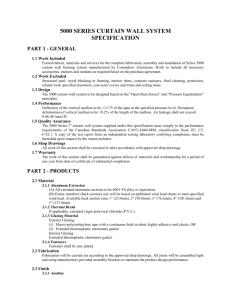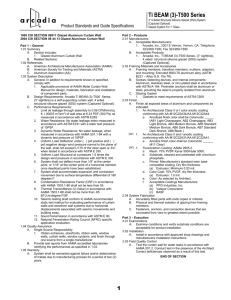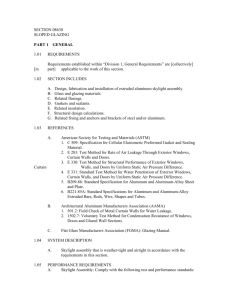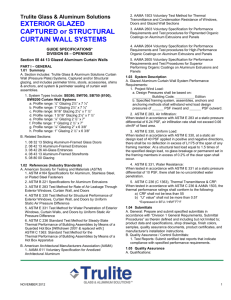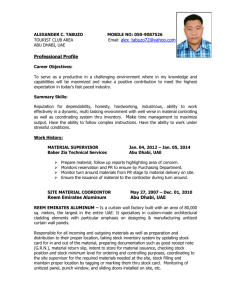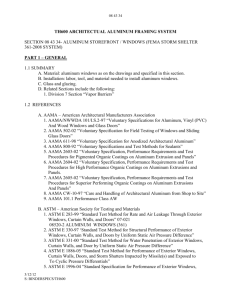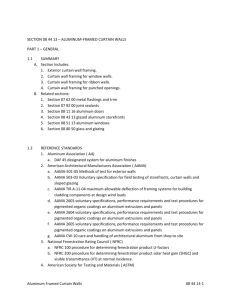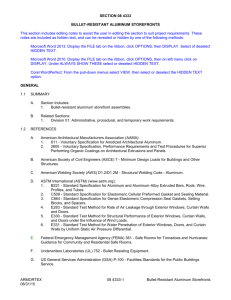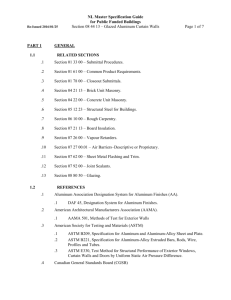Glazed Aluminum Curtain Walls
advertisement
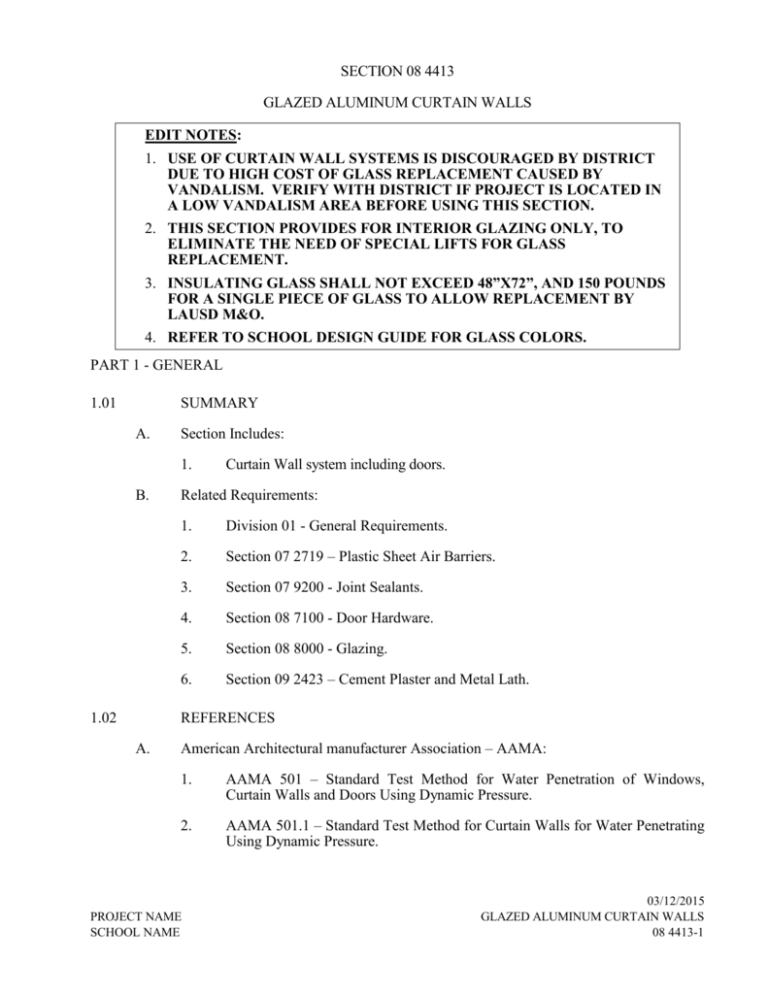
SECTION 08 4413 GLAZED ALUMINUM CURTAIN WALLS EDIT NOTES: 1. USE OF CURTAIN WALL SYSTEMS IS DISCOURAGED BY DISTRICT DUE TO HIGH COST OF GLASS REPLACEMENT CAUSED BY VANDALISM. VERIFY WITH DISTRICT IF PROJECT IS LOCATED IN A LOW VANDALISM AREA BEFORE USING THIS SECTION. 2. THIS SECTION PROVIDES FOR INTERIOR GLAZING ONLY, TO ELIMINATE THE NEED OF SPECIAL LIFTS FOR GLASS REPLACEMENT. 3. INSULATING GLASS SHALL NOT EXCEED 48”X72”, AND 150 POUNDS FOR A SINGLE PIECE OF GLASS TO ALLOW REPLACEMENT BY LAUSD M&O. 4. REFER TO SCHOOL DESIGN GUIDE FOR GLASS COLORS. PART 1 - GENERAL 1.01 SUMMARY A. Section Includes: 1. B. 1.02 Curtain Wall system including doors. Related Requirements: 1. Division 01 - General Requirements. 2. Section 07 2719 – Plastic Sheet Air Barriers. 3. Section 07 9200 - Joint Sealants. 4. Section 08 7100 - Door Hardware. 5. Section 08 8000 - Glazing. 6. Section 09 2423 – Cement Plaster and Metal Lath. REFERENCES A. American Architectural manufacturer Association – AAMA: 1. AAMA 501 – Standard Test Method for Water Penetration of Windows, Curtain Walls and Doors Using Dynamic Pressure. 2. AAMA 501.1 – Standard Test Method for Curtain Walls for Water Penetrating Using Dynamic Pressure. PROJECT NAME SCHOOL NAME 03/12/2015 GLAZED ALUMINUM CURTAIN WALLS 08 4413-1 B. 3. AAMA 501.4 - Testing of Curtain Walls and Storefronts to Resist the Effects of Seismic Loading. 4. AAMA 501.5 - Test Method for Thermal Cycling of Exterior Walls. 5. AAMA 503 – Voluntary Specification for Field Testing of Storefronts, Curtain Walls, and Sloped Glazing Systems. 6. AAMA 611 - Voluntary Specification for Anodized Architectural Aluminum. 7. AAMA 701.2 - Voluntary Specification for Pile Weatherstripping and Replaceable Fenestration Weatherseals. 8. AAMA 1503.1 - Voluntary Test Method for Thermal Transmittance of Windows, Doors and Glazed Wall Sections. American society for Testing and Materials International – ASTM: 1. ASTM A36 – Standard Specification for Carbon Structural Steel. 2. ASTM A1008 – Standard Specification for Steel, Sheet, Cold-Rolled, Carbon, Structural, High-Strength Low-Alloy, High-Strength Low-Alloy with Improved Formability, Solution Hardened, and Bake Hardenable. 3. ASTM A1011 - Standard Specification for Steel, Sheet and Strip, Hot-Rolled, Carbon, Structural, High-Strength Low-Alloy, High-Strength Low-Alloy with Improved Formability, and Ultra-High Strength. 4. ASTM B209 – Standard Specification for Aluminum and Aluminum-Alloy Sheet and Plate. 5. ASTM B221 – Standard Specification for Aluminum and Aluminum-Alloy Extruded Bars, Rods, Wire, Profiles and Tubes. 6. ASTM B429 – Standard Specification for Aluminum-Alloy Extruded Structural Pipe and Tube. 7. ASTM B308 - Standard Specification for Aluminum-Alloy 6061-T6 Standard Structural Profiles. ASTM C509 – Standard Specification for Elastomeric Cellular Preformed Gasket and Sealing Material. 8. ASTM C864 – Standard Specification for Dense Elastomeric Compression Seal Gaskets, Setting Blocks and Spacers. 9. ASTM E90 – Standard Test Method for Laboratory Measurement of Airborne Sound Transmission Loss of Building Partitions and Elements. 10. ASTM E283 – Standard Test Method for Determining Rate of Air Leakage Through Exterior Windows, Curtain Walls, and Doors Under Specified Pressure Differences Across the Specimen. PROJECT NAME SCHOOL NAME 03/12/2015 GLAZED ALUMINUM CURTAIN WALLS 08 4413-2 C. 11. ASTM E330 – Standard Test Method for Structural Performance of Exterior Windows, Doors, Skylights and Curtain Walls by Uniform Static Air Pressure Difference. 12. ASTM E331 - Standard Test Method for Water Penetration of Exterior Windows, Doors, Skylights and Curtain Walls by Uniform Static Air Pressure Difference. National Fenestration Rating Council, Inc.: 1. D. Glass Association of North America (GANA): 1. 1.03 NFRC-102 – Procedure for Measuring the Steady-State Thermal Transmittance of Fenestration Systems. GANA Glazing Manual. PERFORMANCE REQUIREMENTS A. General Performance: Comply with performance requirements specified, as determined by testing of manufacturer's standard glazed aluminum curtain walls representing those indicated for this Project without failure due to defective manufacture, fabrication, installation, or other defects in construction. 1. Glazed aluminum curtain walls shall withstand movements of supporting structure including, but not limited to, story drift, twist, column shortening, long-term creep, and deflection from uniformly distributed and concentrated live loads. 2. Failure also includes the following: a. Thermal stresses transferring to building structure. b. Glass breakage. c. Noise or vibration created by wind and thermal and structural movements. d. Loosening or weakening of fasteners, attachments, and other components. e. Failure of operating units. EDIT NOTE: INDICATE DESIGN LOADS DETERMINED BY PROJECT'S STRUCTURAL ENGINEER ON DRAWINGS OR INSERT LOADS IN THREE SUBPARAGRAPHS BELOW. VERIFY REQUIREMENTS OF AUTHORITIES HAVING JURISDICTION. PROJECT NAME SCHOOL NAME 03/12/2015 GLAZED ALUMINUM CURTAIN WALLS 08 4413-3 B. Air Infiltration: Air leakage through fixed light areas of curtain wall shall not exceed 0.006 cubic feet per square foot of surface when tested in accordance with ASTM E283 at differential static pressure of 6.24 psf. C. Water Infiltration: No water penetration, as defined by AAMA 501.1, when shop tested in accordance with ASTM E331 at an air pressure difference of 12.0 pounds per square foot. D. Thermal Requirements: Framing systems shall accommodate expansion and contraction movement due to surface temperature differentials of 180 degrees Fahrenheit (82 degrees Celsius) without causing buckling, stress on glass, failure of joint seals, excessive stress on structural elements, reduction of performance, or other detrimental effects when tested according to AAMA 501.5. EDIT NOTE: INSERT BELOW DESIGN LOADS DETERMINED BY PROJECT'S STRUCTURAL ENGINEER. E. F. 1.04 Structural Requirements: 1. Provide curtain wall system including anchors capable of withstanding wind load design pressures of [ ] pounds per square foot inward and [ ] pounds per square foot outward. The design pressures are based on the CBC. 2. Deflection: When tested in accordance to ASTM E330 there should be no deflection in excess of L/175 of the span of any framing member. Condensation Resistance Factor (CRF) in accordance with AAMA 1503.1 shall not be less than less than 56 for the frame and 63 for the glass. SUBMITTALS A. Shop Drawings: Submit Shop Drawings for the Work of this section, prepared and reviewed before fabrication. Include plans, elevations, opening, identification symbols, sizes, and complete details for materials, finishes, sizes, profiles, moldings, dimensioned locations of hardware items with reinforcement, methods of anchoring, assembly, installation, isolation, glazing procedure as well as reglazing procedures, materials, flashing and sealants. B. Product Data: Submit manufacturer’s installation instructions, descriptive literature and product specifications, including information for factory finishes, accessories and other required components. C. Material Samples: Window, door and frame sections with specified finish, fasteners, accessories and sealant colors. E. Deferred Approval by Division of the State Architect: 1. PROJECT NAME SCHOOL NAME Submit to the Owner complete sets of drawings and calculations, signed and sealed by a structural engineer currently licensed in the State of California, and specifications for approval by the Division of the State Architect (DSA). 03/12/2015 GLAZED ALUMINUM CURTAIN WALLS 08 4413-4 F. 1.05 2. Allow six months in the schedule for DSA review. 3. Respond to DSA comments and resubmit until final approval is received. Test Reports: 1. Water penetration tests. 2. Air infiltration tests. 3. Structural Windload. 4. Forced Entry Resistance. 5. Thermal tests. QUALITY ASSURANCE A. Installer Qualifications: Certified in writing by manufacturer as qualified for installation of specified systems. B. Welding Qualifications: Qualify procedures and personnel according to the following: 1. AWS D1.1, Structural Welding Code - Steel. 2. AWS D1.2, Structural Welding Code - Aluminum. C. Energy Performance Standards: Comply with NFRC for minimum standards of energy performance, materials, components, accessories, and fabrication. Comply with more stringent requirements if indicated. D. Curtain wall manufacturer shall provide a project specific label certificate using NFRC CMA protocol, listing the U-Factors, solar heat gain coefficients (SHGC), visible transmittance (VT) and air leakage for the fenestration products to adhere to the prescriptive requirements per Title 24. E. Mock-ups: Provide mock-up of one typical door and window unit for review by the ARCHITECT. Coordinate with mock-up requirements of Section 09 2423, Cement Plaster and Metal Lath. F. Pre-Installation Conference: CONTRACTOR shall coordinate and conduct preinstallation conference in accordance to Section 01 3119, Project Meetings, to review the progress of construction activities and preparations for the installation of storefronts and other related work of this Section. 1.06 PROJECT CONDITIONS A. Field Measurements: Verify actual locations of structural supports for glazed aluminum curtain walls by field measurements before fabrication and indicate measurements on Shop Drawings. PROJECT NAME SCHOOL NAME 03/12/2015 GLAZED ALUMINUM CURTAIN WALLS 08 4413-5 1.07 WARRANTY A. Manufacturer shall provide a 10 year material warranty for aluminum curtain wall. B. Manufacturer shall provide a 10 year material warranty for doors. EDIT NOTE: SELECT ONE OF THE FOLLOWING TWO PARAGRAPHS, FOR FINISH WARRANTY. DELETE UNUSED PARAGRAPH. C. Anodized finish of curtain walls, doors and related components shall be warranted for 10 years against cracking, crazing, flaking, or blistering, D. 1.08 DELIVERY, STORAGE AND HANDLING A. B. Pigmented organic finished curtain walls and doors and related components shall be warranted for 15 years against blistering, cracking, peeling or chipping or fading beyond AAMA 2605. Deliver materials in manufacturer’s original, unopened, undamaged containers with identification labels intact. Storage and Protection: Store materials protected from exposure to harmful weather conditions, construction activities and hazards. PART 2 - PRODUCTS 2.01 MANUFACTURERS A. EFCO, System 5900 and Series D518 DuraStile Heavy-Duty Aluminum Entrance Doors. B. Kawneer Company, Inc., 1600 System 5 and 500 Tuffline Wide Stile Doors. C. Arcadia, T500 with WS512HD heavy duty doors. D. Equal. 2.02 SYSTEM DESCRIPTION A. Curtain Wall System: Inside glazed with one inch glazing. B. Doors: Stiles and top rail 5-inch wide and 10 inch high bottom rail. 2.03 MATERIALS A. Aluminum: Alloys and temper recommended by manufacturer for type of use and specified finish. 1. PROJECT NAME SCHOOL NAME Sheet and Plate: ASTM B209. 03/12/2015 GLAZED ALUMINUM CURTAIN WALLS 08 4413-6 B. 2. Extruded Bars, Rods, Profiles and Tubes: ASTM B221. 3. Structural Pipes and Tubes: ASTM B429. 4. Structural Profiles: ASTM B308. 5. Welding Rods and Bare Electrodes: AWS A5.10. Steel Reinforcing: 1. Structural Shapes, Plates, and Bars: ASTM A36. 2. Cold-Rolled Sheet and Strip: ASTM A1008. 3. Hot-Rolled Sheet and Strip: ASTM A1011. C.Shop Coat of Steel Components: Manufacturer's standard zinc-rich, corrosion-resistant primer complying with SSPC-PS Guide No. 12.00; applied immediately after surface preparation and pretreatment. Select surface preparation methods according to recommendations in SSPC-SP COM and prepare surfaces according to applicable SSPC standard. or coat steel using an organic PVDF fluorocarbon coating system conforming to AAMA 2605/2604. 2.04 FRAMING A. Framing Members: Manufacturer's standard extruded- or formed-aluminum framing members of thickness required and reinforced as required to support imposed loads. B. Brackets and Reinforcements: Manufacturer's standard high-strength aluminum with nonstaining, nonferrous shims for aligning system components. C. Fasteners and Accessories: Manufacturer's standard corrosion-resistant, nonstaining, nonbleeding fasteners and accessories compatible with adjacent materials. D. 1. Use self-locking devices where fasteners are subject to loosening or turning out from thermal and structural movements, wind loads, or vibration. 2. Reinforce members as required to receive fastener threads. 3. Use exposed fasteners with countersunk Phillips screw heads finished to match framing system. Anchors: Three-way adjustable anchors with minimum adjustment that accommodate fabrication and installation tolerances in material and finish compatible with adjoining materials, as recommended by manufacturer. 1. PROJECT NAME SCHOOL NAME Concrete and Masonry Inserts: Hot-dip galvanized cast-iron, malleable-iron, or steel inserts complying with ASTM A123 or ASTM A153 requirements. 03/12/2015 GLAZED ALUMINUM CURTAIN WALLS 08 4413-7 E. Concealed Flashing: Manufacturer's standard corrosion-resistant, nonstaining, nonbleeding flashing compatible with adjacent materials. F. Framing Sealants: Manufacturer’s standard sealants. 2.05 GLAZING A. Glazing: Comply with Section 08 8000 - Glazing. B. Glazing Gaskets: C. 2.06 1. Compression type design, replaceable, molded or extruded, of neoprene, or ethylene propylene diene monomer (EPDM). 2. Conform to ASTM C509 or C864. 3. Profile and hardness as required maintaining uniform pressure for watertight seal. 4. Provide in manufacturer's standard black color. Glazing Sealants: Sealants used inside the weatherproofing system shall be approved by the LAUSD Office of Environmental Health and Safety (OEHS). DOOR HARDWARE A. 2.07 Hardware: Finish hardware shall be as specified in Section 08 7100 - Door Hardware. FABRICATION A. B. Coordination of Fabrication: 1. Check actual frame or door openings required in construction work by accurate field measurements before fabrication. 2. Fabricate units to withstand loads which will be applied when system is in place. General: 1. Conceal fasteners wherever possible. 2. Reinforce work as necessary for performance requirements and for support to structure. 3. Separate dissimilar metals and aluminum in contact with concrete utilizing protective coating or pre-formed separators which will prevent contact and corrosion. PROJECT NAME SCHOOL NAME 03/12/2015 GLAZED ALUMINUM CURTAIN WALLS 08 4413-8 4. C. D. E. Comply with Section 08 8000 for glazing requirements. Aluminum Framing: 1. Provide members of size, shape and profile indicated, designed to provide for glazing from interior. 2. Fabricate frame assemblies with joints straight and tight fitting. 3. Reinforce internally with structural members as necessary to support design loads. 4. Maintain accurate relation of planes and angles, with hairline fit of contacting members. 5. Seal horizontals and direct moisture accumulation to exterior. 6. Provide flashings and other materials used internally or externally that are corrosive resistant, non-staining, non-bleeding and compatible with adjoining materials. 7. Provide manufacturer's extrusions and accessories to accommodate expansion and contraction due to temperature changes without being detrimental to appearance or performance. 8. Make provisions in framing for minimum edge clearance, nominal edge cover and nominal pocket width for thickness and type of glazing or infill used in accordance with recommendations of manufacturer and GANA Glazing Manual. 9. Provide tight fitting, injection molded, plastic water deflectors at intermediate horizontals. Entrance Doors: 1. Fabricate with mechanical joints using internal reinforcing plates and shear blocks attached with fasteners and by welding. 2. Provide extruded aluminum glazing stops permanently anchored on security side and removable on opposite side. Hardware: 1. Receive hardware supplied in accordance with Section 08 7000 and install in accordance with requirements of this Section. 2. Cut, reinforce, drill and tap frames and doors as required to receive hardware. 3. Comply with hardware manufacturer's templates and instructions. PROJECT NAME SCHOOL NAME 03/12/2015 GLAZED ALUMINUM CURTAIN WALLS 08 4413-9 4. F. G. Use concealed fasteners wherever possible. Welding: 1. Comply with recommendations of the American Welding Society. 2. Use recommended electrodes and methods to avoid distortion and discoloration. 3. Grind exposed welds smooth and flush with adjacent surfaces; restore mechanical finish. Flashings: Form from sheet aluminum with same finish as extruded sections. Apply finish after fabrication. Material thickness as required to suit condition without deflection or "oil-canning". 1. Major portions of door sections, except glazing beads, shall be nominal 0.125 inch. Glazing stop sections shall have 0.050” wall thickness. 2. Wall thickness of frame members shall be nominal 0.125 inch. H. Door stiles and rails shall be tubular sections, accurately joined at corners with heavy concealed reinforcement brackets secured with bolts and screws, and shall be MIGwelded. Doors shall be furnished with snap-in stops with bulb glazing gasket both sides of glass. Exposed screws are not permitted. Each door leaf shall be furnished with an adjusting mechanism, located in the top rail near the lock stile, which provides for minor clearance adjustments after installation. A hard-backed poly-pile weatherstrip shall be installed in both stiles of center hung single doors. I. The framing system shall provide for flush glazing on sides with no projecting stops. Vertical and horizontal framing members shall same nominal face dimension and overall depth. Door framing members shall match glass framing appearance. 2.08 FINISH EDIT NOTE: SELECT ONE OF THE FOLLOWING TWO PARAGRAPHS, FOR FINISHES. DELETE UNUSED OPTION. A. Curtain Wall, Doors and accessories shall be furnished with an electronically deposited color anodic finish-Class AAM10C22A44 Class I. Thickness shall be 0.7 mil minimum conforming to AAMA 611. A. Curtain Wall, Doors and accessories shall be furnished with an organic finish applied over a five-stage aluminum pre-treatment. Finish shall be a two-coat PVDF fluorocarbon coating system with a minimum of 1.2 mil thickness and conforming to AAMA 2605. PART 3 - EXECUTION PROJECT NAME SCHOOL NAME 03/12/2015 GLAZED ALUMINUM CURTAIN WALLS 08 4413-10 3.01 EXAMINATION A. Examine areas, with Installer present, for compliance with requirements for installation tolerances and other conditions affecting performance of the Work. B. Proceed with installation only after unsatisfactory conditions have been corrected. 3.02 INSTALLATION A. B. 3.03 General: 1. Comply with manufacturer's written instructions. 2. Do not install damaged components. 3. Fit joints to produce hairline joints free of burrs and distortion. 4. Rigidly secure non-movement joints. 6. Install anchors with separators and isolators to prevent metal corrosion and electrolytic deterioration and to prevent impeding movement of moving joints. 7. Weld components in concealed locations to minimize distortion or discoloration of finish. Protect glazing surfaces from welding. 8. Seal joints watertight unless otherwise indicated. Metal Protection: 1. Where aluminum will contact dissimilar metals, protect against galvanic action by painting contact surfaces with primer or by applying sealant or tape or installing nonconductive spacers as recommended by manufacturer for this purpose. 2. Where aluminum will contact concrete or masonry, protect against corrosion by painting contact surfaces with bituminous paint. C. Install components to drain water passing joints, condensation occurring within framing members, and moisture migrating within glazed aluminum curtain wall to exterior. D. Install components plumb and true in alignment with established lines and grades. E. Install operable units level and plumb, securely anchored, and without distortion. Adjust weather-stripping contact and hardware movement to produce proper operation. F. Install glazing as specified in Section 08 8000 - Glazing. FIELD QUALITY CONTROL PROJECT NAME SCHOOL NAME 03/12/2015 GLAZED ALUMINUM CURTAIN WALLS 08 4413-11 A. Manufacturer's representative shall provide periodic site visits to attend pre-installation conference, verify substrate conditions and installation of storefronts are adequate, and resolve issues pertaining to the work of this Section. B. Conduct on-site tests with window manufacturer's representative, Project Inspector, and Architect present. Architect will select units to be tested on the day of the testing. Provide access to windows on each level and façade of the building. Testing shall be performed by a qualified independent testing agency selected by the Owner. C. Ten percent of installed windows shall be selected for water testing. If one or more windows fail, an additional ten percent of windows (not including the ones previously tested) shall be selected by the Architect for further testing. Selection of an additional ten percent of windows and retesting will be preformed until no leaks occur in any of the test samples. D. Water-resistance test: Conduct according to requirements of ASTM E1105. No water leakage is permitted. Windows shall be field tested at 8 PSF test pressure differential. E. Air-infiltration test: Conduct according to requirements of ASTM E783. Allowable infiltration shall not exceed 1.5 times the amount required. Windows shall be tested at 8 PSF field test pressure differential. F. Credit to the Owner the cost of failed tests. 3.04 PROTECTION A. 3.05 Protect the Work of this section until Substantial Completion. CLEAN UP A. Remove rubbish, debris and waste materials and legally dispose of off the Project site. END OF SECTION PROJECT NAME SCHOOL NAME 03/12/2015 GLAZED ALUMINUM CURTAIN WALLS 08 4413-12
